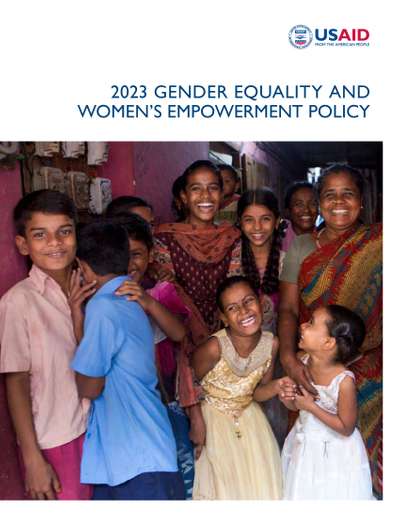USAID Women's Issues Publications
4 Issues in this Publication (Showing 1 - 4)
Optional Social Impact Assessment Framework
USAID,
USAID’s programs, projects and activities assist communities in building greater resilience and, ultimately, becoming self-reliant. Agency decision-makers must balance the potential benefits of activities that aim to build resilience with the possibility that such efforts could have unintended adverse impacts on people and communities. To assist decision-makers in preventing or mitigating such impacts, USAID has a number of policies, guidelines, and vision statements that address issues faced by marginalized people and communities, including:
• Land, property and resource rights
• Human rights
• Environment
• Indigenous Peoples’ rights
• Labor
• Health and Safety
• Inclusive Development
2023 Gender Equality and Women's Empowerment Policy
The U.S. Agency for International Development (USAID) affirms that gender equality and women’s and girls’ empowerment are fundamental for the realization of human rights and key to effective and sustainable development outcomes. For societies to thrive, women and girls, men and boys, and gender-diverse individuals must have the agency, social support, and structures to make their own choices and live free from violence and abuse. They must have equal rights and opportunities, as well as equal and safe access to and control over resources. Achieving gender equality in society will improve the overall quality of life for all people throughout their lives.
This policy provides the vision for USAID’s work to advance gender equality and women’s empowerment around the world—establishing our strategic objectives and driving investments across our operations and programs in order to achieve these aims
Menstrual Health & Hygiene: Technical Brief
Despite being a basic bodily function, menstruation has lived in the shadows across cultures, geographies, and history. In recent years, global health, international development, and women’s rights communities have increasingly recognized the role that menstruation plays in achieving their respective sector objectives, and the many ways in which menstruation can prevent people from contributing freely to their societies. Approaches to addressing menstruation have often been centered within the water, sanitation, and hygiene (WASH) sector, which has resulted in a signifcant programmatic focus on access to latrines and menstrual hygiene products. Eforts from the WASH sector have made signifcant contributions to advance menstrual equity, but alone are insufcient. Holistic MHH interventions require multi-sectoral approaches that combine efforts from the health, education, gender,humanitarian protection , and WASH sectors to address the physical, emotional, economic, and social challenges related to menstruation and to meet the needs of all menstruatorsacross their life cycles. To maximize the impact of MHH investments, USAID staf and partners should consider several cross-cutting issues in activity design and implementation, monitoring and evaluation, and research, including: products and waste management, governance, social support, social and behavior change (SBC), and positive youth development (PYD).
Getting To 2030: Maternal & Child Health & Nutrition Technical Roadmap
For more than 50 years, USAID has worked with countries to deliver a wide range of programs and approaches to save the lives of women, newborns, and children. The results have been impressive. The commitment of countries and the generosity of the American people have resulted in significant reductions in maternal, newborn, and child mortality.
The year 2030 is the target date of Sustainable Development Goal 3 (SDG3) to end preventable child deaths—that is, to achieve mortality rates of equal to or less than 12/1,000 for newborns and equal to or less than 25/1,000 for children under five. It is also the target date for reducing the global maternal mortality ratio to less than 70 per 100,000 live births. In addition, the global community has called attention to the need to prevent stillbirths. In many places, progress towards these goals has stagnated and is at risk of backsliding due to emerging shocks and stressors, such as the impact of the COVID-19 pandemic on health systems, economies and livelihoods, as well as on sexual and gender-based violence; climate change; conflict; and many other factors, especially in fragile settings. The United States government (USG) remains committed to Preventing Child and Maternal Deaths (PCMD) objectives (see Box 1). A sense of urgency, renewed commitments, and new tools, attitudes and behaviors now are needed to reach the global goals for women, newborns, and children. Resilience strengthening efforts are needed to prevent or mitigate the effects of shocks and stresses on vulnerable maternal, newborn and child health and health systems, and to facilitate recovery. While nearly one-third of USAID priority countries are on track to meet their under-five mortality targets, deep inequities persist within and between countries. Few are on track to reach their newborn and maternal mortality targets.



